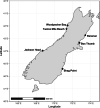Testing effects of bottom-up factors, grazing, and competition on New Zealand rocky intertidal algal communities
- PMID: 38455142
- PMCID: PMC10920032
- DOI: 10.1002/ece3.10704
Testing effects of bottom-up factors, grazing, and competition on New Zealand rocky intertidal algal communities
Abstract
Top-down and bottom-up factors and their interaction highlight the interdependence of resources and consumer impacts on food webs and ecosystems. Variation in the strength of upwelling-mediated ecological controls (i.e., light availability and herbivory) between early and late succession stages is less well understood from the standpoint of influencing algal functional group composition. We experimentally tested the effect of light, grazing, and disturbance on rocky intertidal turf-forming algal communities. Studies were conducted on the South Island of New Zealand at Raramai on the east coast (a persistent downwelling region) and Twelve Mile Beach on the west coast (an intermittent upwelling region). Herbivory, light availability, and algal cover were manipulated and percent cover of major macroalgal functional groups and sessile invertebrates were measured monthly from October 2017 to March 2018. By distinguishing between algal functional groups and including different starting conditions in our design, we found that the mosaic-like pattern of bare rock intermingled with diverse turf-forming algae at Twelve Mile Beach was driven by a complex array of species interactions, including grazing, predation, preemptive competition and interference competition, colonization rates, and these interactions were modulated by light availability and other environmental conditions. Raramai results contrasted with those at Twelve Mile Beach in showing stronger effects of grazing and relatively weak effects of other interactions, low colonization rates of invertebrates, and light effects limited to crustose algae. Our study highlights the potential importance of an upwelling-mediated 3-way interaction among herbivory, light availability, and preemption in structuring contrasting low rocky intertidal macroalgal communities.
Keywords: algae; coastal upwelling; competition; disturbance; grazing; light; rocky intertidal; top‐down/bottom‐up.
© 2024 The Authors. Ecology and Evolution published by John Wiley & Sons Ltd.
Figures








Similar articles
-
Seasonal upwelling reduces herbivore control of tropical rocky intertidal algal communities.Ecology. 2021 Jun;102(6):e03335. doi: 10.1002/ecy.3335. Epub 2021 Apr 18. Ecology. 2021. PMID: 33709403
-
Top-down versus bottom-up: Grazing and upwelling regime alter patterns of primary productivity in a warm-temperate system.Ecology. 2023 Dec;104(12):e4180. doi: 10.1002/ecy.4180. Epub 2023 Nov 1. Ecology. 2023. PMID: 37784259
-
Indirect effects shape macroalgal epifaunal communities.Ecol Evol. 2021 Oct 9;11(21):15141-15152. doi: 10.1002/ece3.8195. eCollection 2021 Nov. Ecol Evol. 2021. PMID: 34765166 Free PMC article.
-
Effects of nutrients, herbivory, and depth on the macroalgal community in the rocky sublittoral.Ecology. 2007 Apr;88(4):839-52. doi: 10.1890/05-0144. Ecology. 2007. PMID: 17536701
-
Macroalgal communities face the challenge of changing biotic interactions: review with focus on the Baltic Sea.Ambio. 2007 Apr;36(2-3):203-11. doi: 10.1579/0044-7447(2007)36[203:mcftco]2.0.co;2. Ambio. 2007. PMID: 17520935 Review.
References
-
- Aguilera, M. A. , & Navarrete, S. A. (2007). Effects of Chiton granosus (Frembly, 1827) and other molluscan grazers on algal succession in wave exposed mid‐intertidal rocky shores of Central Chile. Journal of Experimental Marine Biology and Ecology, 349, 84–98.
-
- Alestra, T. , Gerrity, S. , Dunmore, R. A. , Crossett, D. , Orchard, S. , & Schiel, D. R. (2021). Rocky reef impacts of the 2016 Kaikoura earthquake: Extended monitoring of nearshore habitats and communities to 3.5 years. 253. Fisheries New Zealand.
-
- Bertness, M. D. , Leonard, G. H. , Levine, J. M. , & Bruno, J. F. (1999). Climate‐driven interactions among rocky intertidal organisms caught between a rock and a hot place. Oceologia, 120(3), 446–450. - PubMed
-
- Bokn, T. L. , Duarte, C. M. , Pedersen, M. F. , Marbà, N. , Moy, F. E. , Barrón, C. , Bjerkeng, B. , Borum, J. , Christie, H. , Engelbert, S. , Fotel, F. L. , Hoell, E. , Karez, R. , Kersting, K. , Kraufvelin, P. , Lindblad, C. , Olsen, M. , Sanderud, K. , Sommer, U. , & Sørensen, K. (2003). The response of experimental rocky shore communities to nutrient additions. Ecosystems, 6(6), 577–594.
-
- Bosman, A. L. , Hockey, P. A. R. , & Siegfried, W. R. (1987). The influence of coastal upwelling on the functional structure of rocky intertidal communities. Oecologia, 72, 226–232. - PubMed
Associated data
LinkOut - more resources
Full Text Sources

